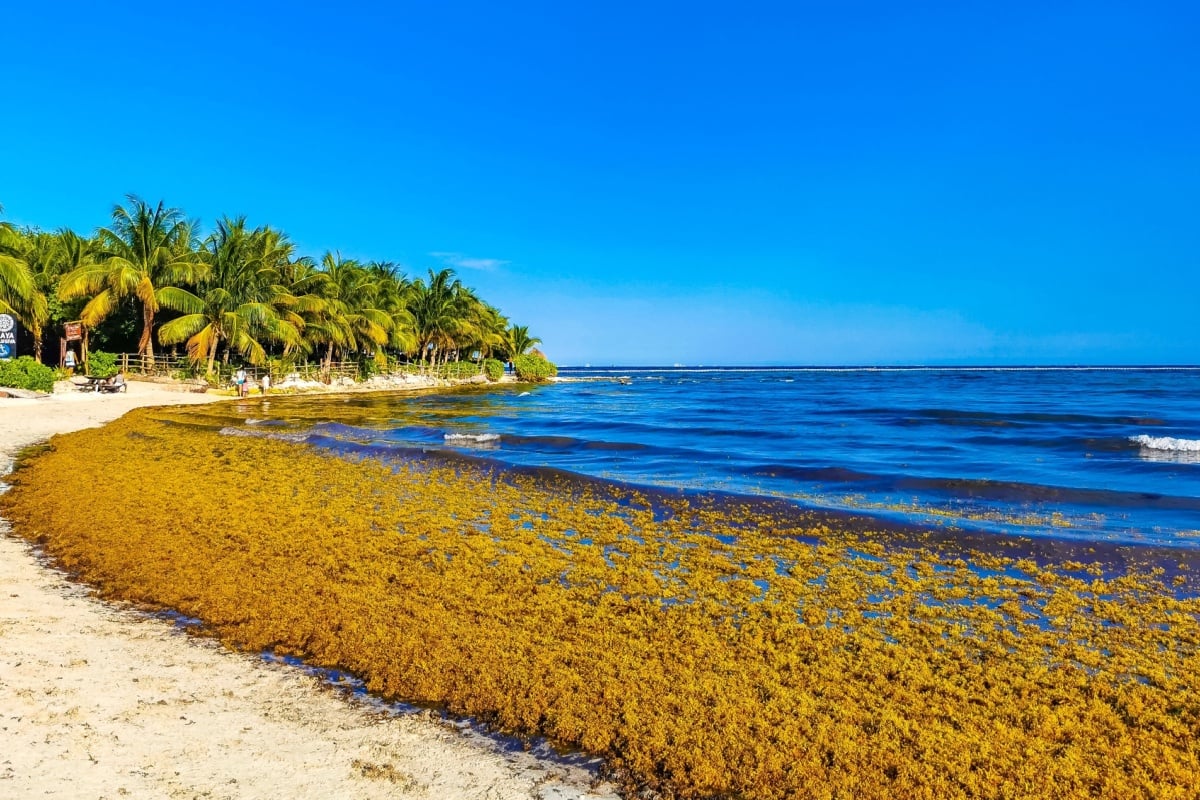Share the article
Last updated
Sargassum is a major problem for many travelers during the summer months.
By the way, it ruins pristine white sand beaches, it stinks terribly, and it can even keep you from swimming in the ocean.

Definitely not what you want on your dream beach vacation!
Are you worried that sargassum could affect your next trip? I have bad news! The biggest sargassum invasion in years is coming.
Here’s what you need to know:
A massive Sargassum invasion is coming
a press release of Quintana Roo’s Sargazo Monitoring Network has revealed that there is currently an incredible and overwhelming mass of sargassum floating in the Honduran Caribbean.


This mass is currently no less than 5,000 square kilometers in size. That’s about 10 times the length of the island of Cozumel.
And the bad news is that dominant east-west winds mean this mass will reach the waters of the Mexican Caribbean in the coming weeks.
This is one of the largest sargassum masses the region has seen in years.


The director of the Sargazo Monitoring Network reported that between 200 and 300 thousand tons of sargassum are expected to arrive on the coast of the Mexican Caribbean this summer.
That is significantly more than the same coastline has experienced in recent years.
Which regions will be affected by this Sargassum?
The six regions that will be affected by this incredible sargassum invasion are:
- The Mexican Caribbean coast
- The Dominican Republic
- Jamaica
- The Lesser Antillean Arc Islands
- The Turks and Caicos Islands
- The Miami area of the Florida peninsula, USA
All of these regions will be hardest hit during the summer months.


June, July and August are expected to be the months when the most sargassum will land and the result will be devastating beaches across the board.
Why is Sargassum bad news?
Sargassum seaweed is a naturally occurring brown algae that blooms every year in the Atlantic Ocean.
It provides a home for marine animals and other organisms, and is vital to the ocean ecosystem.
But it is not such good news for tourists.
Although sargassum is generally not dangerous, it ruins the appearance of normally pristine beaches.
When it reaches the coast and lands on these beaches, a few days under the hot sun means it also starts to stink and rot. Rotting sargassum produces hydrogen sulfide.
At this point, sargassum can become dangerous. Hydrogen sulfide can cause breathing problems in people who are sensitive to it.


Because of this, as well as the animals and microorganisms that can live in sargassum, it is best not to touch it. Especially with bare hands.
How do the affected destinations deal with Sargassum?
Many Mexican Caribbean destinations, including Cancun and Tulum, have installed sargassum barriers to prevent the seaweed from reaching the coast.
These barriers do not completely eliminate the problem and sargassum will still wash up on the shoreline, but they do help reduce the amount.


Beyond these barriers, the most common way destinations like Mexico, Jamaica and the Dominican Republic deal with sargassum is to simply remove it.
A job that is easier said than done!
Dredge pumps, tractors and the handiwork of dedicated teams lifting the sargassum by hand using rakes and wheelbarrows all help to remove as much sargassum as possible.
If you stay at a resort with a private beach, you will find that your resort has a dedicated team of staff who clean the beaches as quickly as possible.
Many resort beaches are full of sargassum early in the morning, but can be used by resort guests in the afternoon.


A top tip?
If you’re planning a vacation to one of the six destinations listed above, where sargassum is expected to be plentiful this year, make sure your resort or hotel offers both a pool and beach access.
That way you have a place to relax and unwind if the beach isn’t as clean as you’d like.


SUBSCRIBE TO OUR LATEST POSTS
Enter your email address to subscribe to the latest Travel Off Path breaking travel news, delivered straight to your inbox.
This article originally appeared on TravelOffPath.com
The opinions expressed here are solely those of the author, and not those of any bank, credit card issuer, hotel, airline or other entity. This content has not been reviewed, approved, or otherwise endorsed by any of the entities included in the post.





